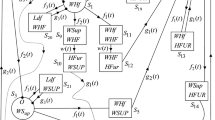Abstract
System availability is becoming an increasingly important factor in evaluating the behavior of commercial computer systems. This is due to the increased dependence of enterprises on continuously operating computer systems and to the emphasis on fault-tolerant designs. Thus, we expect availability modeling to be of increasing interest to computer system analysts and for performance models and availability models to be used to evaluate combined performance/availability (performability) measures. Since commercial computer systems are repairable, availability measures are of greater interest than reliability measures. Reliability measures are typically used to evaluate nonrepairable systems such as occur in military and aerospace applications. We will discuss system aspects which should be represented in an availability model; however, our main focus is a state of the art summary of analytical and numerical methods used to solve computer system availability models. We will consider both transient and steady-state availability measures and for transient measures, both expected values and distributions. We are developing a program package for system availability modeling and intend to incorporate the best solution methods.
Similar content being viewed by others
References
F. Baskett, K.M. Chandy, R.R. Muntz and F.G. Palacios, Open, closed and mixed networks of queues with different classes of customers, Journal of ACM, 22, 2(1975)248.
M.D. Beaudry, Performance-related reliability measures for computing systems, IEEE Trans. on Computers 27, 6(1978)540.
R.C. Buck and E.F. Buck,Introduction to Differential Equations (Houghton Mifflin Co., Boston, 1976).
W.-L. Cao and W.J. Stewart, Iterative aggregation/disaggregation techniques for nearly decomposable Markov chains, JACM (1985), to appear.
L. Donatiello and B. Iyer, Analysis of a composite performance reliability measure for fault tolerant systems, Revised IBM Research Report RC-10325, Yorktown Heights, JACM (1985), in review.
R.M. Geist and K.S. Trivedi, Ultrahigh reliability prediction for fault-tolerant computer systems, IEEE Trans. on Computers 32, 12(1983).
A. Goyal and A.N. Tantawi, Evaluation of performability for degradable computer systems, IBM Research Report RC-10529, Yorktown Heights (1984).
A. Goyal and A.N. Tantawi, Numerical evaluation of guaranteed availability, Proc. FTCS-15 (1985).
A. Goyal, On steady state availability modeling, in preparation.
A. Goyal, Product-form in steady state availability models, in preparation.
W.K. Grassman, Transient solutions in Markovian queueing systems, Computers in Operations Research 4(1977)47.
D. Gross, L.C. Kioussis, D.R. Miller and R.M. Soland, Computational aspects of determining steady-state availability for Markovian multi-echelon repairable item inventory models, Tech. Rep. GWU/IMSE/Serial T-483/84, The George Washington University (1984).
D. Gross and D.R. Miller, The randomization technique as a modeling tool and solution procedure for transient Markov processes, Oper. Res. 32, 3(1984)343.
T.E. Hull, W.H. Enright, B.M. Fellen and A.E. Sedgewick, Comparing numerical methods for ordinary differential equations, University of Toronto Department of Computer Science Tech. Rep. No. 29 (1971).
B. Iyer, L. Donatiello and P. Heidelberger, Performability evaluation of computing systems using reward models, IBM Research Report RC-10719, Yorktown Heights (1984).
A. Jensen, Markoff chains as an aid in the study of Markoff processes, Skand. Aktuarietidskr. 36(1953)87.
L. Kaufman, B. Gopinath and E.F. Wunderlich, Analysis of packet network congestion control using sparse matrix algorithms, IEEE Trans. on Communications 29, 4(1981)453.
J.G. Kemeny and J.L. Snell,Finite Markov Chains (D. Van Nostrand Co., Princeton, NJ, 1967).
L.C. Kioussis and D.G. Miller, An importance sampling scheme for simulating the degradation and failure of complex systems during finite missions, Proc. Winter Simulation Conf., Washington (1983) p. 631.
V. Kini, Automatic synthesis of symbolic reliability functions for processor-memory-switch structures, Ph.D. Dissertation, Carnegie-Mellon University (1981).
V.G. Kulkarni, V.F. Nicola and K.S. Trivedi, On modeling the performance and reliability of multi-mode computer systems, Int. Workshop on Modeling and Performance Evaluation of Parallel Systems (North-Holland, Amsterdam, 1984).
V.G. Kulkarni, V.F. Nicola, K.S. Trivedi and R.M. Smith, Numerical evaluation of performability and job completion time in repairable fault-tolerant systems, Proc. FTCS-16 (1986).
J.D. Lambert,Computational Methods in Ordinary Differential Equations (Wiley, New York, 1973).
C. Landrault and J.C. Laprie, SURF-a program for modelling and reliability prediction for fault-tolerant comput. syst., in:Information Technology, ed. J. Moneta (North-Holland, Amsterdam, 1978).
S.S. Lavenberg, editor,Computer Performance Modeling Handbook (Academic Press, New York, 1983).
B. Melamed and M. Yadin, Randomization procedure in computation of comulative-time distributions over discrete state Markov Processes, Oper Res. 32, 4(1984)926.
J.F. Meyer, On evaluating the performability of degradable computing systems, IEEE Trans. on Computers 29, 8(1980)720.
S.V. Makam, A. Avizienis and G. Grusas, UCLA ARIES 82 user's guide, Tech. Rep. No. CSD-820830 (1982).
T. Nakagawa and A.L. Goel, A note on availability for a finite interval, IEEE Trans. on Reliability 22, 3(1973)271.
S.M. Ross,Stochastic Processes (Wiley, New York, 1983).
D.P. Seiwiorek and R.S. Swarz,The Theory and Practice of Reliable System Design (Digital Press, 1982).
W.L. Smith, Renewal theory and its ramifications, J. Roy. Statist. Soc. Ser. B20(1958)243.
W.J. Stewart, Markov analysis of operating system techniques, Ph.D. Thesis, Queen's University of Belfast (1974).
W.J. Stewart, A comparison of numerical techniques in Markov modeling, CACM 21, 2 (1978).
W.J. Stewart and A. Goyal, Matrix methods in large dependability models, IBM Research Report RC 11485 (1985).
K.S. Trivedi,Probability & Statistics with Reliability, Queueing, and Computer Science Applications (Prentice-Hall, 1982).
R.S. Varga,Matrix Iterative Analysis (Prentice-Hall, 1962).
Author information
Authors and Affiliations
Rights and permissions
About this article
Cite this article
Goyal, A., Lavenberg, S.S. & Trivedi, K.S. Probabilistic modeling of computer system availability. Ann Oper Res 8, 285–306 (1987). https://doi.org/10.1007/BF02187098
Issue Date:
DOI: https://doi.org/10.1007/BF02187098




